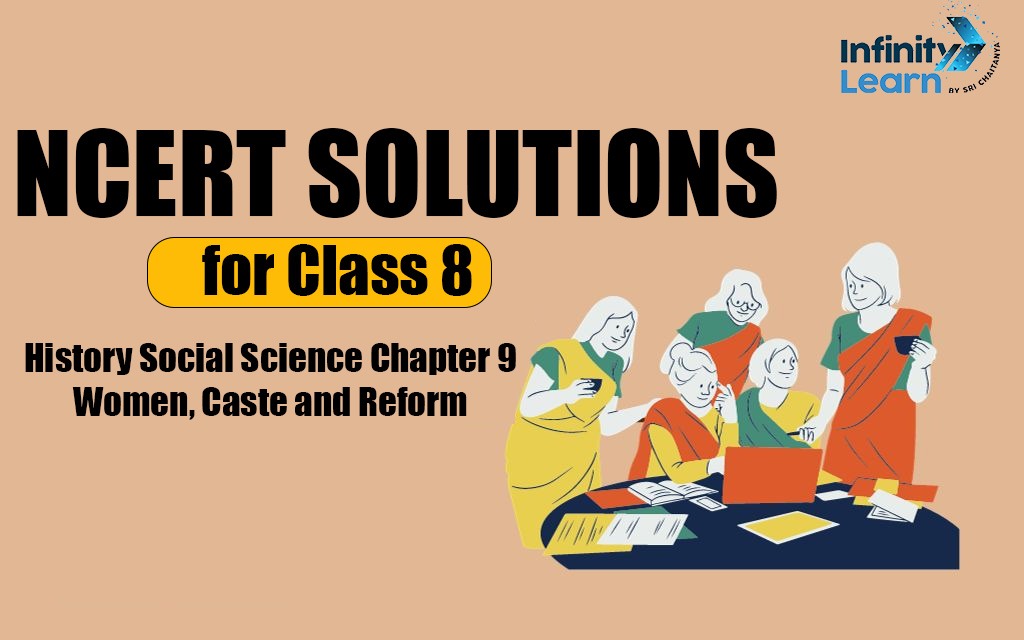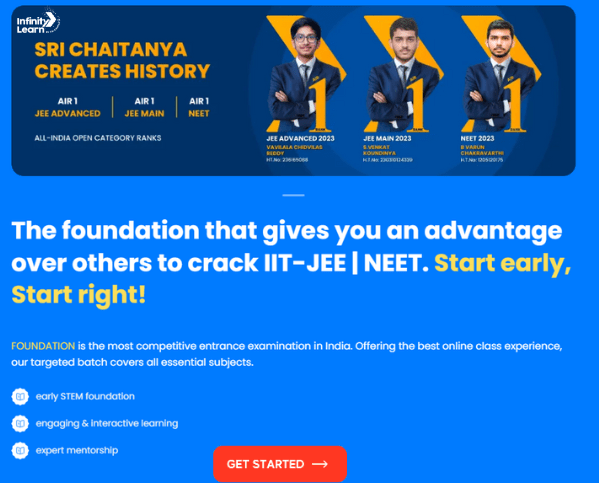Table of Contents
Discover the NCERT Solutions for Class 8 History Chapter 9, which focuses on the important topic of women, caste, and reform. This chapter explains the significant social changes that occurred during the 19th and 20th centuries, highlighting the movements aimed at improving the status of women and eliminating caste-based discrimination.
The solutions for women, caste, and reform class 8 question answer provide clear and simple explanations, helping students understand these historical events and their impact. Whether you are preparing for exams or simply want to learn more about history, these answers are written to match the CBSE Syllabus Class 8, making it easier for students to grasp the concepts.
With the NCERT solutions, students can confidently approach questions like women caste and reform question answer and learn in a structured way. The detailed answers also cover various textbook questions, ensuring you are well-prepared for any assessment.
Explore the complete set of class 8 women caste and reform question answer to make history engaging and fun to learn. From reform movements for women’s rights to efforts in breaking caste barriers, these solutions bring history alive with easy-to-understand explanations.
Start learning now and excel in your studies with NCERT Solutions for Class 8 History Chapter 9: Women, Caste, and Reform!

NCERT Solutions for Class 8 History Chapter 9 – Women, Caste, and Reform PDF Download
NCERT Solutions for Class 8 History chapter 9 Women Caste and Reform help students in understanding the topic better. NCERT Solutions by Infinity Learn are considered a particularly beneficial resource for examination.
NCERT Solutions for Class 8 Social Science History Chapter 9 Women Caste Reform gives students a plus with practical questions. this might help them be highly equipped for exams. These solutions helps students enhance their knowledge. NCERT Solutions Class 8- Chapter 9, “Women Caste Reform,” provides all the important key points of the chapter for last-minute preparation.
NCERT Solutions Chapter 9 for Women Caste and Reform Class 8 Question Answer
Question: What social ideas did the following people support?
Answer: Rammohun Roy, Dayanand Saraswati, Veerasalingam Pantulu, Jyotirao Phule, Pandita Ramabai, Periyar, Mumtaz Ali, Ishwar Chandra Vidyasagar
- Rama Mohan Roy: Sati Pratha abolition, Supporter of western education
- Dayanand Saraswati: Founder of Arya Samaj, also supported widow remarriage.
- Veerasalingam Pantulu: In the Telugu-speaking areas of the Madras Presidency, Veerasalingam Panthulu formed an association for widow remarriage.
- Jyotirao Phule: Caste equality
- Pandita Ramabai: She wrote a book about the pathetic condition of upper-caste Hindu widows. She set up a widow home at Poona to give shelter to widows.
- Periyar or E.V.: Self-respect movement, untouchability
- Mumtaz Ali: Advocating gender equality, women’s rights
- Ishwar Chandra: Remarriage of widows
Question: State whether true or false
a. When the British captured Bengal, they framed many new laws to regulate the rules regarding marriage, adoption, inheritance of property, etc.
Answer: True
b. Social reformers had to discard the ancient texts to argue for reform in social practices.
Answer: False
c. Reformers got full support from all sections of the country’s people.
Answer: False
d. The Child Marriage Restraint Act was passed in1829.
Answer: True
Question: How did the knowledge of ancient texts help the reformers promote new laws?
Answer: From the early nineteenth century, people began to think about societal changes regarding social customs and practices.
- The most important reason for this was the development of new forms of communication.
- Books, newspapers, magazines, leaflets, and pamphlets were printed.
- They were cheap and more accessible than the manuscripts.
- Ordinary people could read them.
- Many of them could write and express their ideas in their languages.
Question: What were the different reasons people had for not sending girls to school?
Answer: When the first schools were opened in the mid-nineteenth century, many people were afraid of them.
- They feared that schools would take girls away from home.
- They would prevent them from doing their domestic duties.
- Girls had to travel through public places to reach school. This would have a corrupting influence on them.
- Girls should stay away from public spaces.
Question: Why did many people in the country attack Christian missionaries? Would some people have supported them too? If so, for what reasons?
Answer:
- Many people attacked Christian Missionaries in the country because they suspected that they were involved in the forced conversion of poor and tribal people from Hinduism to Christianity.
- The Christian Missionaries began setting up schools for the Tribal and lower caste children.
- So, the Tribal and lower caste people supported them as their children were equipped with some resources to make their way into the changing World.
Question: In the British period, what new opportunities opened up for people from castes that were regarded as “low”?
Answer:
- With the expansion of cities, new demands for labour were created.
- Drains had to be dug, roads were laid, buildings constructed, and cities cleaned. It required coolies, diggers, carriers, bricklayers, sweepers, rickshaw pullers, etc.,
- This labour came from people belonging to the “low” caste. They left their villages and small towns and shifted to the cities to get work.
- People went to work in different places like Assom, Mauritius, and Indonesia. Although it was not easy to work in the new locations, poor people saw this as an opportunity to get away from the exploitations of the upper caste.
Question: How did Jyotirao the reformers justify their criticism of caste inequality in society?
Answer:
- Jyotirao attacked the Brahman’s claim of their superiority over others. He argued the Aryas were foreigners, who came from outside the subcontinent.
- They defeated and subjugated the true children of the country.
- According to Phule, the “upper” castes had no right to their land and power; in reality, the land belonged to the so-called low castes.
- He proposed that the Shudras (labour castes) and untouchables should unite to challenge caste discrimination.
- The Satyashodak Samaj association founded by Phule propagated caste equality.

Class 8 HOTS Course
The Class 8 HOTS Course enhances critical thinking and problem-solving skills through engaging activities and advanced learning techniques, ensuring academic excellence.
Question: Why did Phule dedicate his book Gulamgiri to the American movement to free slaves?
Answer: In 1873, Phule wrote Gulamgiri. It means slavery.
- Some ten years before, the American Civil War resulted in the abolition of slavery in America.
- Phule dedicated his book to all those Americans who fought to abolish slaves. Thus this book set up close relations between “lower” castes in India and the enslaved Black people in America.
- Phule extended his criticism of the caste system to argue against all forms of inequality.
- He was pained to see the plight of upper-caste women, the laborers’ miseries, and the low castes’ humiliation.
Question: What did Ambedkar want to achieve through the temple entry movement?
Answer:
- Ambedkar was born in a Mahar family. In childhood, he experienced various caste prejudices in his everyday life.
- He was not allowed to drink water from taps meant for the upper caste; he was made to sit outside the classroom on the ground.
- After finishing school, he got a fellowship to go to the U.S. for higher studies. After returning, he tried for the temple entry movement.
- Mahar caste people participated in it.
- Ambedkar led three such movements for temple entry between 1927 and 1935.
- He aimed to make everyone see the power of a caste prejudice within society.
Questions: Why were Jyoti Rao Phule and Ramaswamy Naicker critical of the national movement? Did their criticism help the national struggle in any way?
Answer: E.V. Ramaswamy Naicker or Periyar came from a middle class family.
- They were against the injustice of the caste system.
- They were critical of the national movement run by the upper caste leaders because they held that this would serve the purpose of the upper.
- After the movement, these people again continue this cruel practice of untouchability.
- Even Periyar left the congress in the earlier days of an incidence of untouchability.
- Yes, their criticism helped the national movement struggle to bring unity among people.
- Such lower caste leaders’ speeches, writings, and movements made the Indians rethink the evil practice.
Other study resources for class 8 available at IL
- NCERT Solutions for Class 8 Maths
- NCERT Solutions for Class 8 English
- NCERT Solutions for Class 8 Science
- NCERT Exemplar for Class 8 Maths
- NCERT Exemplar for Class 8 Science
Class 8 Social Science Chapter 9
NCERT Solutions Class 8 Chapter 9 Women Caste Reform helps students score good marks in the exam. The solutions included are easy to know, with every step within the solution described intimately. It’s very easy to download NCERT Solution Women Caste Reform Class 8 Chapter 9 PDF online from the INFINITY LEARN website and app. NCERT Solutions will assist you in building a robust foundation for this chapter.
The fabric will also offer you the capacity to answer different questions associated with this chapter. During the examination, you do not have to worry as you’ll learn about the chapter in a concise time from this guide. NCERT Solution Class 8 Science Chapter 9 Women Caste Reform provides all the specified questions and answers with the simplest explanation.
NCERT Solutions for Class 8 Chapter 9 Women Caste and Reform Question Answer
NCERT Solution Class 8 History Chapter 9 Women’s Caste Reform belongs to the textbook Our Past III. This chapter is about why girls weren’t allowed to travel to high school, why are Jyoti Rao Phule and Ramaswamy Naicker critical of the national movement, new opportunities for people belonging to lower castes, who were allowed to travel to temples, etc. These topics are covered with all the details from the chapter. It’s explained in simple language and is remembered very easily.
Class 8 History Chapter-wise Marks Weightage
Class 8th History Chapter 9 features a weightage of 20 marks, and this is often one of the foremost important topics. You’ll easily score more marks in CBSE Class 8 History by completely practicing with our study materials, including NCERT Solutions, revision notes, etc.; you want to have a sound knowledge of this subject to attain better. You’ll also think about question patterns and the best techniques to write down great answers.
Here are More Detail About the Contents of Chapter 9 Women Caste Reform Class 8
- 9.1 Why girls were not allowed to go to school? (1 long)
- 9.2 What opportunities were opened for lower caste people? (1 short)
- 9.3 Who was allowed to go to temples? (2 short)
- 9.4 Why did many people in the country attack Christian missionaries (2 long)
- 9.5 True or False (3-4 short)
Why are NCERT Solutions for sophistication 8 History Chapter 9 Important?
- NCERT Solution will assist you to prepare for the exam in less duration of your time.
- We have provided here the simplest and therefore the simplest answers to all or any of the questions given in Chapter 8 of NCERT History Book for sophistication 8.
- Our solutions will increase students’ knowledge about the topic and also help to enhance their grades.
- It contains all the important details which are required for last-minute preparation.
- Our study material strengthens the understanding and learning abilities of scholars of CBSE Class 8.
NCERT Solutions for Class 8 History Chapter 9 FAQs
What is caste and social reform in Class 8?
In Class 8, caste and social reform typically refers to a chapter or topic in the curriculum that explores the caste system in India and the efforts made by social reformers to address its inequalities.
What is the chapter of women caste reform?
The chapter on Women, Caste, and Reform likely discusses the intersection of gender and caste issues in India's history and the reform movements related to them.
Who are the social reformers of women caste and reform?
Prominent social reformers in the context of women, caste, and reform in India include Raja Ram Mohan Roy, Jyotirao Phule, and Dr. B.R. Ambedkar, among others.
What is caste reforms?
Caste reforms refer to efforts and movements aimed at challenging and reforming the caste system in India to reduce discrimination and promote equality among different caste groups.
What is caste and social reform?
Caste and social reform encompass initiatives and movements that seek to address social inequalities, particularly those related to the caste system in India, through various reforms and changes in societal attitudes.
What is called social reform?
Social reform refers to actions and movements that strive to bring about positive changes in society by addressing and rectifying social injustices, inequalities, and harmful practices.
What do you mean by reform in Class 8?
In Class 8, reform typically refers to the process of making improvements or changes in social, cultural, or historical contexts, often focusing on issues like caste discrimination and other societal problems.
What is the meaning of reform in social?
In a social context, reform signifies efforts and actions aimed at ameliorating or rectifying issues, practices, or systems that are deemed problematic, unjust, or outdated, with the goal of achieving positive social change.










